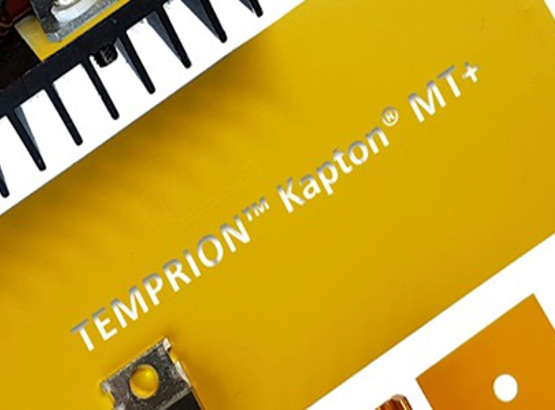The advantages of insulation films are
- the low thickness of the material (usually only 0.025 - 0.05 mm)
- the very high dielectric strength
- and the short distance required for heat transport.
In many cases, this completely compensates for the disadvantage of low thermal conductivity (rule of thumb: for the same desired heat flow, a material with twice the specific thermal conductivity must be used for twice the material thickness).

However, insulation foils are not flexible. They cannot penetrate into the irregularities of surfaces like other materials (silicone mats, gap fillers, potting compounds, thermal paste). As a result, 30-40% of the contact area between the heat source and heat sink can be lost. Heat transport is worsened by air pockets (no direct contact).
This disadvantage is compensated for by TIM coatings. This is generally understood to mean coatings that are suitable for displacing the air pockets between microscopically rough surfaces. To do this, these surface finishes of thermally conductive insulation foils must be soft enough to penetrate such irregularities and create a form-fit. CMC Klebetechnik has various solutions for this task, which will be presented in the following:
-
Phase-change coating; these coating compounds are solid at room temperature but melt quite early (55-60°C). They then flow into the surface irregularities and fill them. This creates a positive connection between the heat source and heat sink.
-
Thermally conductive acrylic adhes ives combine heat conduction and adhesive strength. CMC Klebetechnik offers two variants: an adhesive that is already quite mobile below 100°C and has moderate adhesive strength, and a high-performance acrylate adhesive that can be used up to 180°C.
-
Thermally conductive silicone coatings that can be either adhesive or non-adhesive. They withstand temperatures even above 200°C and are very resistant to aging.
In order to get a feeling for how strong the influence of TIM coatings of CMC adhesive technology are, measurements were carried out. For this purpose, the bare film and coated films with non-thermally conductive and thermally conductive TIM coatings were compared with each other:
Exemplary measured values (measurement method ASTM D5470, NOT Laserflash):
Kapton® MT+ without coating: 0.28 W/m*K
Kapton® MT+ with non-thermally conductive adhesive: 0.36 W/m*K
Kapton® MT+ with thermally conductive adhesive: 0.73 W/m*K
Kapton® MT+ with phase change coatings: 0.84 W/m*K
As can be seen clearly, with the same base film, heat conduction is significantly improved when a coating with Thermal Interface Material is applied. The thermally conductive variant (same layer thickness) doubles the heat transfer and is at about the same level as the theoretical specific thermal conductivity value of Kapton® MT+ (0.85 W/m*K). But it is only with the TIM coating that the very good Kapton® MT+ can fully exploit its advantages.
Better heat dissipation leads to longer life of electronic components and thus greater reliability of your equipment!
Important note
Kapton® MT+ is an advanced thermally conductive film from DuPont. This film offers almost twice the thermal conductivity of the standard Kapton® MT product. Due to a significantly higher price, it is reserved for special applications that absolutely require good thermal conductivity combined with high electrical dielectric strength. Kapton® MT+ is not a permanently stocked Kapton® variant at CMC Klebetechnik.
How important are coatings on thermally conductive films?